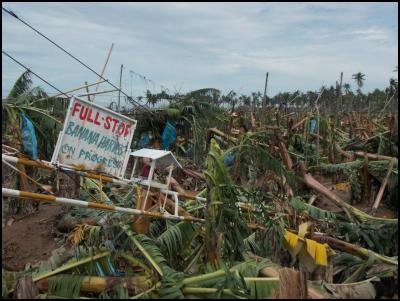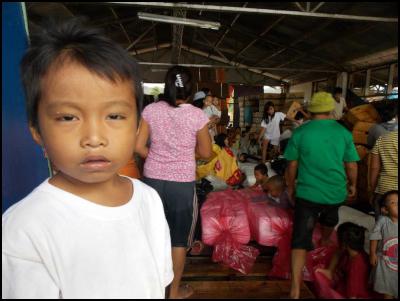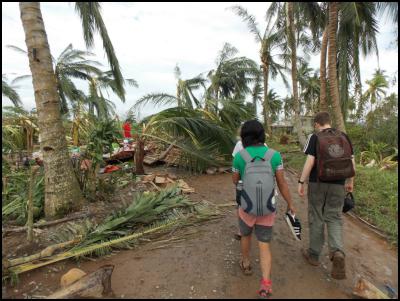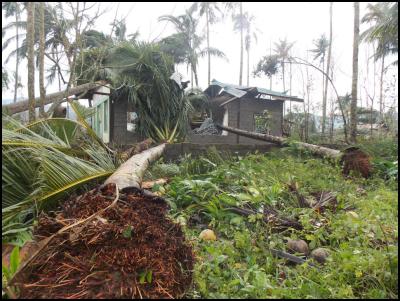Getting Caught in the Deadly Philippines Typhoon

Getting Caught in the Deadly Philippines Typhoon
By Cameron WalkerTyphoon Bopha (known as Typhoon Pablo in the Philippines) hit the southern island of the Philippines, Mindanao, with tremendous force during the early hours of December 4th 2012. The confirmed death toll is 1067 with over 800 people still listed as missing.
I was in the Compostela Valley, one of the worst hit regions of the country, during the typhoon. The Filipino trade union organisation Kilusang Mayo Uno (KMU) had organised for me to visit their members in a small village called Osmeña. Most of the locals there work in the banana plantations that surround the village, earning 5 pesos (NZ 14 cents) from the multinational fruit company, Sumifru, for every stem they cut.
In recent years the workers have overcome many difficulties, including intimidation from the Armed Forces of the Philippines, to organise a union.
When I arrived in Osmeña on the evening of December 3rd Tommy, the worker whose house I stayed at, invited me to come banana harvesting with him. The workers harvest bananas from 1am to 1pm to ensure the fruit is not ruined by the heat. I politely declined because I had been up since early in the morning and needed some rest.
Pablo arrives
At around 4am I was woken up by the sound of heavy rain and fast winds. One of the organisers, who had accompanied me to Osmeña from Davao, informed me I needed to join the rest of the family and other visitors on the porch because a coconut tree was swinging violently above the part of the house I was sleeping. On the porch we sheltered under a table as coconuts and trees crashed to the ground. The corrugated iron roof started to tear off in the wind.
The house was next to a stream that had become a raging torrent. Fallen trees and other debris sped downstream. The waters were starting to flood onto the porch so we had to leave to find higher ground.
I followed my friends over broken trees and debris. They ran ahead and I lost them. I tried calling out but my voice was drained out by the wind. I just followed in the direction I thought they had gone to and found a sturdy house where around 50 locals were sheltering. The people inside beckoned from the windows for me to come in. My friends intended to go to another house but had run back to find me and ended up reaching the same house as me.

Hospitality in the disaster zone
The neighbouring houses had become piles of rubble on the ground. Residents were salvaging what they could.
Despite all of this the locals seemed very concerned about me. “Excuse me would you like some milk? Would you like some water?”. A small child handed me a mango.
The children were doing their best to mop the flood waters out of the sturdy house but eventually it became too much and the water flooded inside. We had to leave again.

The relief centre
Relief centre
We waded through flood water to arrive at the relief centre – a raised banana packing house. It was to be our home for the next 24 hours. At least 100 of us were crammed into the small space.
We slept on the foam sheets used to wrap bananas and draped our bodies in plastic sheets to stay warm. After becoming waterlogged one could become teeth chattering cold despite the Philippine heat.
Everyone tried their best to keep the relief centre dry but with many sopping wet people arriving this was easier said than done. I slept on top of a small puddle.
Throughout the night babies and toddlers let out the type of distressed cries that children only make when they are really sick. However, the adults continued to put on a brave face. When I fell in the mud on a trip back from the toilet one man smiled, pointed at his skin and then pointed at mine to say I was starting to look like a Filipino. Everybody around us burst into laughter.

Inside the relief centre
The next morning
Once morning came we returned back to the house and were really happy to see Tommy had arrived back. He explained that he had been trapped in flood waters up to his neck in the banana fields.
We received word that the highway was open and the organisers in Davao had sent a ute to pick us up. As we made the half hour walk from Osmeña to the highway, we saw that the banana fields surrounding the village had been flattened by the winds. Fields, which had two days earlier contained hectare upon hectare of banana trees, now resembled a desert.
The workers in Osmeña are only paid if they are able to harvest the bananas. They have not only lost their homes but also their livelihood. It will take a long time to recover.

Walking to the highway
Only 5km away from Compostela, in New Bataan, hundreds of people were swept to their deaths in flash flooding. In the days following the disaster local media broadcast many sad pictures and stories of how the local farmers had been reduced to begging passing motorists for food after all their crops were destroyed in the flooding.
While travelling down the highway outside of Osmeña I finally saw my first sign of the Filipino state since the typhoon hit the previous day. A small truck with members of the AFP (Armed Forces of the Philippines), toting large assault rifles, on the back cruised down the road. Unlike the NZ Army in Christchurch following the earthquake they did not seem equipped to engage in disaster relief.

Supporting the relief missions
Unfortunately Filipinos are not able to rely on the state for support in times of disaster. Communities have to pull together with the support of some private development agencies. Migrante Aotearoa New Zealand, an organisation of Filipino migrants in New Zealand has opened a bank account to collect donations for the relief fund. The money will be given to an organisation called The People’s Mobilisation for Disaster Relief and Climate Justice (BALSA Mindanao), that is co-ordinating grassroots relief efforts in the Compostela Valley, New Bataan and other regions affected by the typhoon.
A few days after the typhoon I was able to see first hand BALSA Mindanao’s good work when I accompanied a mission to deliver desperately needed food aid to the worst affected areas of Compostela.
More than a month after the typhoon, the efforts of BALSA Mindanao and other relief agencies continue. Schools, homes and other infrastructure need to be rebuilt and crops must be replanted. Many typhoon victims are still stuck in relief centres and temporary shelter.
If you are able to even give a couple of dollars to support it would be much appreciated. One New Zealand dollar goes a long way in the Philippines.
Details for donations
Donations can be sent to Migrante Aotearoa’s ASB account.
Account name: Migrante Aotearoa New Zealand Incorporated; Account Number: 12-3136-0276480-00
Please write flood relief in the particulars.
For more information contact Amie Dural Maga of Migrante Aotearoa
Email: secretariat@migrante-aotearoa.org.nz

Cameron Walker is an Arts/Law student at the University of Auckland and a member of Auckland Philippines Solidarity. He recently returned from a three week exposure programme with the human rights and trade union movement in the Philippines


 Martin LeFevre - Meditations: In A Global Society, There Is No Such Thing As “National Security”
Martin LeFevre - Meditations: In A Global Society, There Is No Such Thing As “National Security” Binoy Kampmark: Secrecy And Virtue Signalling - Another View Of Signalgate
Binoy Kampmark: Secrecy And Virtue Signalling - Another View Of Signalgate Gordon Campbell: On The Americanising Of NZ’s Public Health System
Gordon Campbell: On The Americanising Of NZ’s Public Health System Ian Powell: Trumpian Health Leadership
Ian Powell: Trumpian Health Leadership Eugene Doyle: Disruption - Historians Challenge Russophobic Propaganda
Eugene Doyle: Disruption - Historians Challenge Russophobic Propaganda Ramzy Baroud: War, Doublethink, And The Struggle For Survival - Geopolitics Of The Gaza Genocide
Ramzy Baroud: War, Doublethink, And The Struggle For Survival - Geopolitics Of The Gaza Genocide